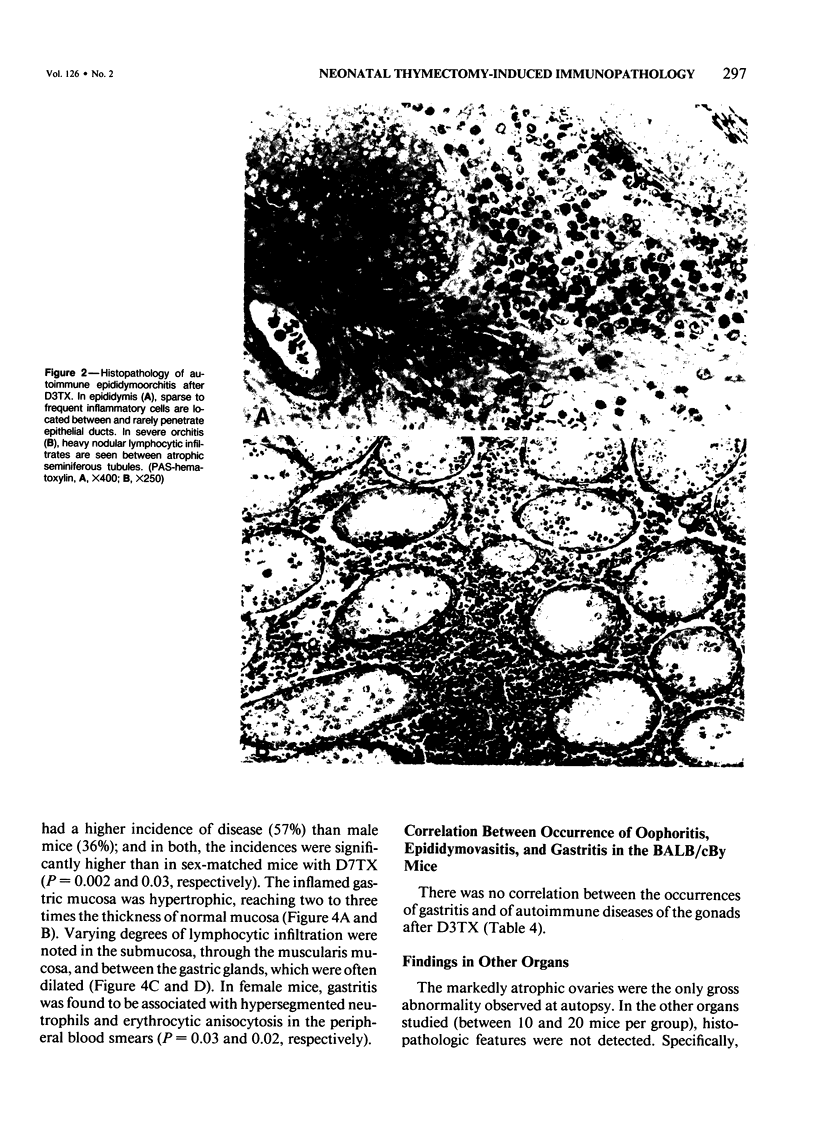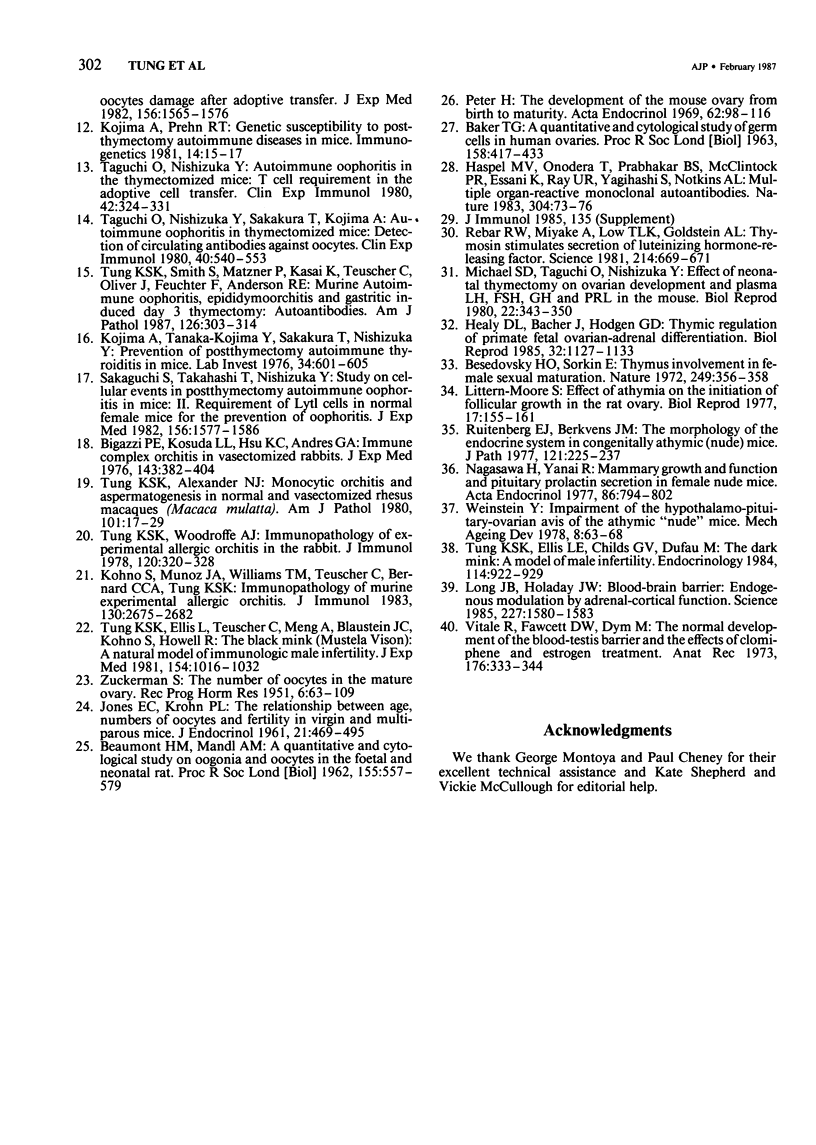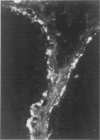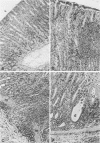Abstract
(C57BL/6 X A/J) F1, (SWR/J X A/J) F1 and BALB/cBy mice, thymectomized on Day 3 (D3TX) or Day 7 (D7TX) or sham thymectomized (STX), were studied for immunopathologic changes in the ovary, testis, and gastric wall. In 95% of B6AF1, 100% of SWRAF1, and 35% of BALB/cBy mice ovarian disease developed, with onset at 5-6 weeks of age. Ovarian disease was not found in D7TX or STX mice. In D3TX mice, it was associated with mononuclear infiltration and ovarian follicle destruction, leading to atrophy. Epididymovasitis was detected in 70-90% of SWRAF1, 50% of B6AF1, and 64% of BALB/cBy mice after D3TX; whereas orchitis occurred in about 20% of SWRAF1 and B6AF1 mice. In some mice epididymovasitis also developed after D7TX, but not after STX. In contrast to the negative immunohistochemical findings in diseased ovaries, typical immune complex-like deposits of mouse IgG were detected by immunofluorescence along the basement membrane of epididymal ducts and seminiferous tubules. However, maximum incidence of epididymitis preceded immune complex detection. Gastritis developed in both female (57%) and male (50%) BALB/cBy mice after D3TX, occasionally after D7TX, but not after STX. Gastric mucosa was hypertrophic with dilated glands and heavy lymphocytic infiltrations throughout all gastric layers. BALB/cBy mice with gastritis usually did not have disease in the gonads, and vice versa. This study, therefore, confirms and extends the findings of Nishizuka and colleagues.
Full text
PDF









Images in this article
Selected References
These references are in PubMed. This may not be the complete list of references from this article.
- BAKER T. G. A QUANTITATIVE AND CYTOLOGICAL STUDY OF GERM CELLS IN HUMAN OVARIES. Proc R Soc Lond B Biol Sci. 1963 Oct 22;158:417–433. doi: 10.1098/rspb.1963.0055. [DOI] [PubMed] [Google Scholar]
- Besedovsky H. O., Sorkin E. Thymus involvement in female sexual maturation. Nature. 1974 May 24;249(455):356–358. doi: 10.1038/249356a0. [DOI] [PubMed] [Google Scholar]
- Bigazzi P. E., Kosuda L. L., Hsu K. C., Andres G. A. Immune complex orchitis in vasectomized rabbits. J Exp Med. 1976 Feb 1;143(2):382–404. doi: 10.1084/jem.143.2.382. [DOI] [PMC free article] [PubMed] [Google Scholar]
- Haspel M. V., Onodera T., Prabhakar B. S., McClintock P. R., Essani K., Ray U. R., Yagihashi S., Notkins A. L. Multiple organ-reactive monoclonal autoantibodies. Nature. 1983 Jul 7;304(5921):73–76. doi: 10.1038/304073a0. [DOI] [PubMed] [Google Scholar]
- Healy D. L., Bacher J., Hodgen G. D. Thymic regulation of primate fetal ovarian-adrenal differentiation. Biol Reprod. 1985 Jun;32(5):1127–1133. doi: 10.1095/biolreprod32.5.1127. [DOI] [PubMed] [Google Scholar]
- JONES E. C., KROHN P. L. The relationships between age, numbers of ocytes and fertility in virgin and multiparous mice. J Endocrinol. 1961 Feb;21:469–495. doi: 10.1677/joe.0.0210469. [DOI] [PubMed] [Google Scholar]
- Kohno S., Munoz J. A., Williams T. M., Teuscher C., Bernard C. C., Tung K. S. Immunopathology of murine experimental allergic orchitis. J Immunol. 1983 Jun;130(6):2675–2682. [PubMed] [Google Scholar]
- Kojima A., Prehn R. T. Genetic susceptibility to post-thymectomy autoimmune diseases in mice. Immunogenetics. 1981;14(1-2):15–27. doi: 10.1007/BF00344296. [DOI] [PubMed] [Google Scholar]
- Kojima A., Taguchi O., Nishizuka Y. Experimental production of possible autoimmune castritis followed by macrocytic anemia in athymic nude mice. Lab Invest. 1980 Apr;42(4):387–395. [PubMed] [Google Scholar]
- Kojima A., Tanaka-Kojima Y., Sakakura T., Nishizuka Y. Prevention of postthymectomy autoimmune thyroiditis in mice. Lab Invest. 1976 Jun;34(6):601–605. [PubMed] [Google Scholar]
- Kojima A., Tanaka-Kojima Y., Sakakura T., Nishizuka Y. Spontaneous development of autoimmune thyroiditis in neonatally thymectomized mice. Lab Invest. 1976 Jun;34(6):550–557. [PubMed] [Google Scholar]
- Lintern-Moore S. Effect of athymia on the initiation of follicular growth in the rat ovary. Biol Reprod. 1977 Sep;17(2):155–161. doi: 10.1095/biolreprod17.2.155. [DOI] [PubMed] [Google Scholar]
- Long J. B., Holaday J. W. Blood-brain barrier: endogenous modulation by adrenal-cortical function. Science. 1985 Mar 29;227(4694):1580–1583. doi: 10.1126/science.3975627. [DOI] [PubMed] [Google Scholar]
- Michael S. D., Taguchi O., Nishizuka Y. Effect of neonatal thymectomy on ovarian development and plasma LH, FSH, GH and PRL in the mouse. Biol Reprod. 1980 Mar;22(2):343–350. doi: 10.1093/biolreprod/22.2.343. [DOI] [PubMed] [Google Scholar]
- Nagasawa H., Yanai R. Mammary growth and function and pituitary prolactin secretion in female nude mice. Acta Endocrinol (Copenh) 1977 Dec;86(4):794–802. doi: 10.1530/acta.0.0860794. [DOI] [PubMed] [Google Scholar]
- Nishizuka Y., Sakakura T. Thymus and reproduction: sex-linked dysgenesia of the gonad after neonatal thymectomy in mice. Science. 1969 Nov 7;166(3906):753–755. doi: 10.1126/science.166.3906.753. [DOI] [PubMed] [Google Scholar]
- Peters H. The development of the mouse ovary from birth to maturity. Acta Endocrinol (Copenh) 1969 Sep;62(1):98–116. doi: 10.1530/acta.0.0620098. [DOI] [PubMed] [Google Scholar]
- Rebar R. W., Miyake A., Low T. L., Goldstein A. L. Thymosin stimulates secretion of luteinizing hormone-releasing factor. Science. 1981 Nov 6;214(4521):669–671. doi: 10.1126/science.7027442. [DOI] [PubMed] [Google Scholar]
- Ruitenberg E. J., Berkvens J. M. The morphology of the endocrine system in congenitally athymic (nude) mice. J Pathol. 1977 Apr;121(4):225–231. doi: 10.1002/path.1711210406. [DOI] [PubMed] [Google Scholar]
- Sakaguchi S., Takahashi T., Nishizuka Y. Study on cellular events in post-thymectomy autoimmune oophoritis in mice. II. Requirement of Lyt-1 cells in normal female mice for the prevention of oophoritis. J Exp Med. 1982 Dec 1;156(6):1577–1586. doi: 10.1084/jem.156.6.1577. [DOI] [PMC free article] [PubMed] [Google Scholar]
- Sakaguchi S., Takahashi T., Nishizuka Y. Study on cellular events in postthymectomy autoimmune oophoritis in mice. I. Requirement of Lyt-1 effector cells for oocytes damage after adoptive transfer. J Exp Med. 1982 Dec 1;156(6):1565–1576. doi: 10.1084/jem.156.6.1565. [DOI] [PMC free article] [PubMed] [Google Scholar]
- Scollay R., Bartlett P., Shortman K. T cell development in the adult murine thymus: changes in the expression of the surface antigens Ly2, L3T4 and B2A2 during development from early precursor cells to emigrants. Immunol Rev. 1984 Dec;82:79–103. doi: 10.1111/j.1600-065x.1984.tb01118.x. [DOI] [PubMed] [Google Scholar]
- Singer A., Hathcock K. S., Hodes R. J. Self recognition in allogeneic thymic chimeras. Self recognition by T helper cells from thymus-engrafted nude mice is restricted to the thymic H-2 haplotype. J Exp Med. 1982 Jan 1;155(1):339–344. doi: 10.1084/jem.155.1.339. [DOI] [PMC free article] [PubMed] [Google Scholar]
- Taguchi O., Nishizuka Y. Autoimmune oophoritis in thymectomized mice: T cell requirement in adoptive cell transfer. Clin Exp Immunol. 1980 Nov;42(2):324–331. [PMC free article] [PubMed] [Google Scholar]
- Taguchi O., Nishizuka Y. Experimental autoimmune orchitis after neonatal thymectomy in the mouse. Clin Exp Immunol. 1981 Nov;46(2):425–434. [PMC free article] [PubMed] [Google Scholar]
- Taguchi O., Nishizuka Y., Sakakura T., Kojima A. Autoimmune oophoritis in thymectomized mice: detection of circulating antibodies against oocytes. Clin Exp Immunol. 1980 Jun;40(3):540–553. [PMC free article] [PubMed] [Google Scholar]
- Tung K. S., Alexander N. J. Monocytic orchitis and aspermatogenesis in normal and vasectomized rhesus macaques (Macaca mulatta). Am J Pathol. 1980 Oct;101(1):17–29. [PMC free article] [PubMed] [Google Scholar]
- Tung K. S., Ellis L. E., Childs G. V., Dufau M. The dark mink: a model of male infertility. Endocrinology. 1984 Mar;114(3):922–929. doi: 10.1210/endo-114-3-922. [DOI] [PubMed] [Google Scholar]
- Tung K. S., Ellis L., Teuscher C., Meng A., Blaustein J. C., Kohno S., Howell R. The black mink (Mustela vison). A natural model of immunologic male infertility. J Exp Med. 1981 Oct 1;154(4):1016–1032. doi: 10.1084/jem.154.4.1016. [DOI] [PMC free article] [PubMed] [Google Scholar]
- Tung K. S. Immune complex in the renal glomerulus during normal pregnancy. A study in the guinea pig and the mouse. J Immunol. 1974 Jan;112(1):186–200. [PubMed] [Google Scholar]
- Tung K. S., Smith S., Matzner P., Kasai K., Oliver J., Feuchter F., Anderson R. E. Murine autoimmune oophoritis, epididymoorchitis, and gastritis induced by day 3 thymectomy. Autoantibodies. Am J Pathol. 1987 Feb;126(2):303–314. [PMC free article] [PubMed] [Google Scholar]
- Tung K. S., Woodroffe A. J. Immunopathology of experimental allergic orchitis in the rabbit. J Immunol. 1978 Jan;120(1):320–328. [PubMed] [Google Scholar]
- Vitale R., Fawcett D. W., Dym M. The normal development of the blood-testis barrier and the effects of clomiphene and estrogen treatment. Anat Rec. 1973 Jul;176(3):331–344. doi: 10.1002/ar.1091760309. [DOI] [PubMed] [Google Scholar]
- Weigle W. O. Analysis of autoimmunity through experimental models of thyroiditis and allergic encephalomyelitis. Adv Immunol. 1980;30:159–273. doi: 10.1016/s0065-2776(08)60196-0. [DOI] [PubMed] [Google Scholar]
- Weinstein Y. Impairment of the hypothalamo-pituitary-ovarian axis of the athymic "nude" mouse. Mech Ageing Dev. 1978 Jul;8(1):63–68. doi: 10.1016/0047-6374(78)90007-6. [DOI] [PubMed] [Google Scholar]
- Wilson R., Bealmear M., Sjodin K. A technique for thymectomizing germfree mice. J Appl Physiol. 1966 Jan;21(1):279–281. doi: 10.1152/jappl.1966.21.1.279. [DOI] [PubMed] [Google Scholar]






